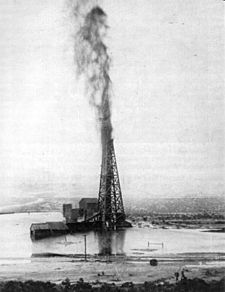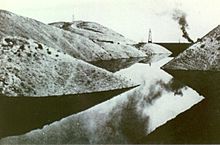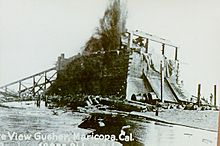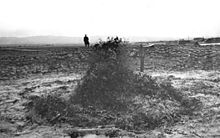Lakeview Gusher facts for kids
Quick facts for kids Lakeview Gusher Number One |
|
|---|---|

The Lakeview gusher with a lake of crude oil surrounding the derrick, mid-1910
|
|
| Location | Kern County, California |
| Coordinates | 35°05′29″N 119°24′05″W / 35.091424°N 119.401377°W |
| Date | 14 March 1910 – September 1911 |
| Cause | |
| Cause | Wellhead blowout |
| Operator | Lakeview Oil Company |
| Spill characteristics | |
| Volume | 9 million barrels (1.4×106 m3) |
| Reference #: | 485 |
Lakeview Gusher Number One was an eruption of hydrocarbons from a pressurized oil well in the Midway-Sunset Oil Field in Kern County, California, in 1910. It created the largest accidental oil spill in history, lasting 18 months and releasing 9 million barrels (1.4×106 m3) of crude oil.
Midway-Sunset was one of the largest oil reserves in the United States. When drilling commenced, the Lakeview Oil Company expected natural gas and a small amount of oil. Instead, there was a large blowout which overloaded storage tanks.
The geyser released more than 1.2 million short tons (1,100,000 t) of crude oil, far more than any other single leak on land or water. Its site is located about a half-mile (800 m) east of the Taft–Maricopa Highway, California Route 33, marked by a Caltrans guide sign and a bronze plaque designated as California Historical Landmark number 485.
Background
The Lakeview Oil Company started drilling at its Number One well on 1 January 1909. Initially only natural gas was found. As work continued the company partnered with the Union Oil Company, which wanted to build storage tanks there.
Early twentieth-century drilling technology lacked such modern safety features as blowout preventers. When drilling reached a well depth of 2,440 ft (740 m) on 15 March 1910, pressurized oil blew through the well casing above the bit. An estimated 9 million barrels (1.4×106 m3) escaped before the gusher was brought under control in September 1911.
The initial daily flow was 18,800 barrels (2,990 m3), creating a river of crude that crews rushed to contain with improvised sand bag dams and dikes. Peak flow reached 90,000 barrels (14,000 m3) per day, diverted via a pipeline to storage tanks 2.5 miles (4.0 km) away, where an 8-inch (200 mm) line led to Port Avila on the coast. In spite of these efforts, less than half of the 9.4 million barrels released during the gusher's 544 days were saved. The rest evaporated or seeped into the ground. The fact that the oil field didn't catch fire is a miracle.
California Historical Landmark
The California Historical Landmark reads:
- NO. 485 LAKEVIEW GUSHER 1 - America's most spectacular gusher blew in here on March 14, 1910. Initially 18,000 barrels per day, the flow later reached an uncontrolled peak of 100,000 barrels per day, completely destroying the derrick. This Union Oil Company well produced nine million barrels of oil in 18 months. Marker date of registration August 7, 1951.





